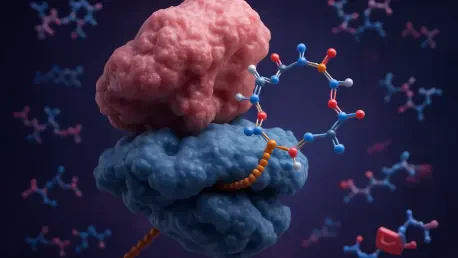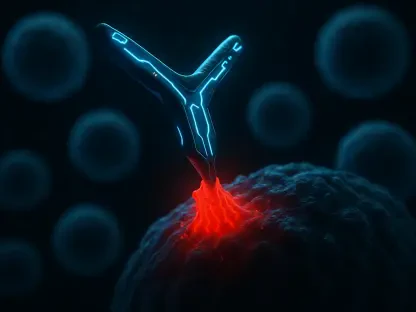Imagine a world where the tiniest cellular machines, responsible for crafting the building blocks of life, are harnessed to create powerful new drugs capable of targeting diseases with unprecedented precision, and this vision is inching closer to reality thanks to groundbreaking research in synthetic biology. Scientists have recently achieved a monumental feat by adapting ribosomes—nature’s protein factories—to produce ring-shaped, or cyclic, peptides instead of the traditional linear chains. This innovation, spearheaded by a team at Pohang University of Science and Technology (POSTECH) in South Korea, could transform drug design by offering more stable and effective therapeutic compounds. Beyond medicine, it opens doors to advanced biomaterials, blending biology and chemistry in ways previously thought impossible. Published in a leading scientific journal, this discovery challenges long-held assumptions about ribosomal capabilities and sets a new frontier for molecular science.
Breaking Barriers in Ribosomal Function
The journey to this breakthrough begins with understanding the fundamental role of ribosomes, which have operated as cellular assembly lines for billions of years, stitching amino acids into linear protein chains. These linear structures, while essential to life, often lack the durability and binding strength needed for effective drug molecules, as they can degrade quickly or fail to latch onto targets like cancer cells or viruses. Cyclic peptides, with their ring-shaped backbones, offer a compelling alternative due to their enhanced stability and ability to bind more tightly to specific targets. However, synthesizing these structures through traditional chemical methods has proven cumbersome and inefficient, often requiring complex processes that limit scalability. The idea of leveraging ribosomes to directly produce cyclic peptides represents a radical shift, sidestepping the constraints of chemical synthesis and tapping into the efficiency of biological systems for a more streamlined approach to drug development.
This innovative leap was made possible not by altering the ribosome itself but by redesigning the amino acids it uses as raw materials. Researchers at POSTECH engineered a unique set of 26 amino acids that naturally attract each other during the synthesis process, prompting the formation of ring structures like pentagons and hexagons within the ribosome. Conducted under standard biological conditions, this method relies on the ribosome’s inherent mechanisms, demonstrating an elegant adaptation of an ancient system. Unlike past attempts that struggled with control and consistency, this approach allows for precise tailoring of the resulting cyclic shapes. The significance lies in its simplicity and scalability—using a cell-free protein synthesis system, the process mirrors natural conditions without needing external catalysts. This milestone builds on earlier achievements by the same team in collaboration with international partners, marking a steady progression toward mastering ribosomal capabilities for novel outputs.
Transforming Drug Development and Beyond
The implications of ribosomes synthesizing cyclic peptides are profound, particularly for the pharmaceutical industry, where the demand for more robust and targeted drugs continues to grow. Cyclic peptides, with their superior stability and binding affinity, could become game-changers in treating complex diseases, offering solutions where linear peptides fall short. For instance, their durability makes them less prone to breakdown in the body, potentially reducing dosages and side effects for patients. Moreover, their enhanced ability to lock onto specific molecular targets could lead to breakthroughs in precision medicine, tackling conditions like cancer or viral infections with greater efficacy. By enabling ribosomes to produce these structures directly, the research eliminates many of the bottlenecks associated with chemical synthesis, paving the way for faster, more cost-effective drug development pipelines that could bring life-saving treatments to market sooner.
Beyond therapeutics, this advancement holds promise for material science through the creation of advanced biomaterials. Ribosomes capable of crafting cyclic structures could be used to synthesize novel compounds with unique properties, such as increased strength or flexibility, for applications ranging from medical implants to industrial materials. This dual potential underscores the versatility of the discovery, positioning it as a cornerstone for innovation across multiple fields. Professor Joongoo Lee, who led the POSTECH team, has highlighted how these ribosomal processes mirror classic chemical reactions, suggesting that deeper insights into the ribosome’s intricate workings could unlock further secrets of life and evolution. Supported by significant funding from South Korea’s Ministry of Science and ICT, this work reflects a broader trend in synthetic biology toward harnessing natural systems for cutting-edge solutions, blending scientific disciplines to address some of humanity’s most pressing challenges.
A New Era for Synthetic Biology
Reflecting on this landmark achievement, it’s evident that the adaptation of ribosomes to create cyclic peptides marks a turning point in scientific exploration. The meticulous design of amino acids to facilitate ring formation within a biological system showcases human ingenuity at its finest, bridging the gap between nature’s ancient machinery and modern needs. This feat, accomplished through rigorous experimentation, stands as a testament to the power of interdisciplinary collaboration, drawing from biology, chemistry, and engineering to redefine what is possible. The successful synthesis under natural conditions further highlights the practicality of the method, ensuring it isn’t just a theoretical triumph but a tangible step forward. Looking ahead, the focus should shift to scaling these findings, integrating them into industrial processes for drug and material production. Continued investment in synthetic biology research will be crucial, as will partnerships between academia and industry to translate these molecular innovations into real-world impact.









